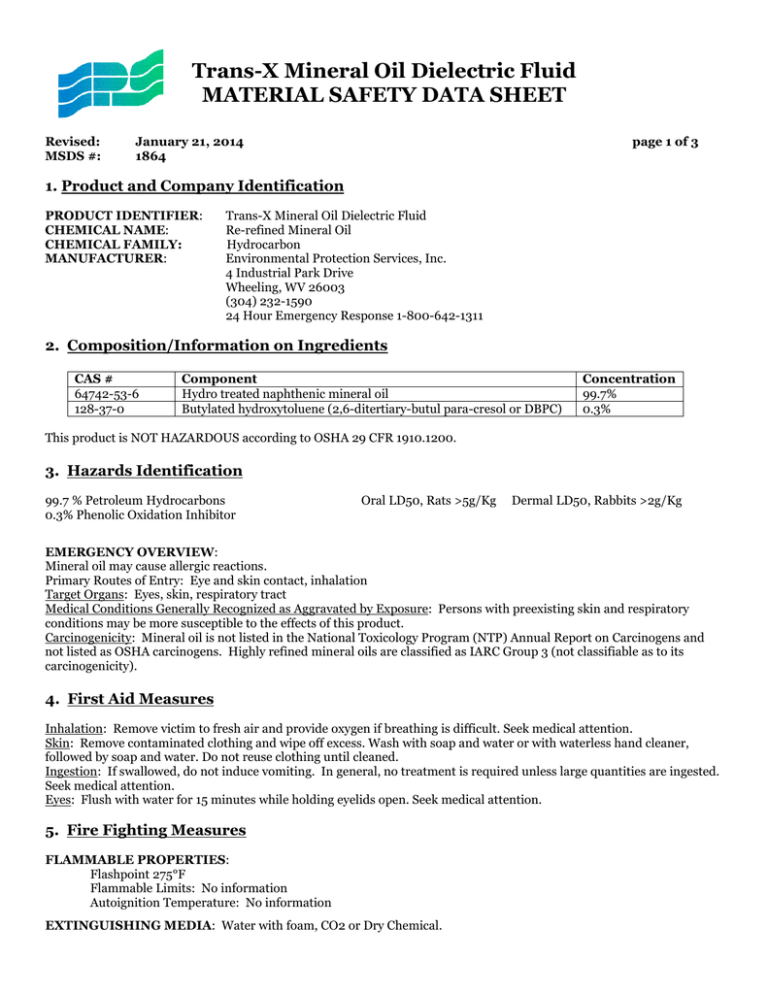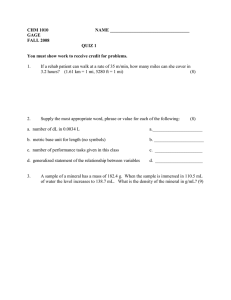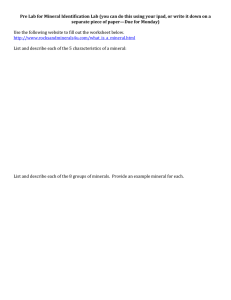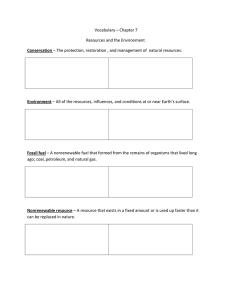Trans-X Mineral Oil Dielectric Fluid MATERIAL SAFETY DATA SHEET
advertisement

Trans-X Mineral Oil Dielectric Fluid MATERIAL SAFETY DATA SHEET Revised: MSDS #: January 21, 2014 1864 page 1 of 3 1. Product and Company Identification PRODUCT IDENTIFIER: CHEMICAL NAME: CHEMICAL FAMILY: MANUFACTURER: Trans-X Mineral Oil Dielectric Fluid Re-refined Mineral Oil Hydrocarbon Environmental Protection Services, Inc. 4 Industrial Park Drive Wheeling, WV 26003 (304) 232-1590 24 Hour Emergency Response 1-800-642-1311 2. Composition/Information on Ingredients CAS # 64742-53-6 128-37-0 Component Hydro treated naphthenic mineral oil Butylated hydroxytoluene (2,6-ditertiary-butul para-cresol or DBPC) Concentration 99.7% 0.3% This product is NOT HAZARDOUS according to OSHA 29 CFR 1910.1200. 3. Hazards Identification 99.7 % Petroleum Hydrocarbons 0.3% Phenolic Oxidation Inhibitor Oral LD50, Rats >5g/Kg Dermal LD50, Rabbits >2g/Kg EMERGENCY OVERVIEW: Mineral oil may cause allergic reactions. Primary Routes of Entry: Eye and skin contact, inhalation Target Organs: Eyes, skin, respiratory tract Medical Conditions Generally Recognized as Aggravated by Exposure: Persons with preexisting skin and respiratory conditions may be more susceptible to the effects of this product. Carcinogenicity: Mineral oil is not listed in the National Toxicology Program (NTP) Annual Report on Carcinogens and not listed as OSHA carcinogens. Highly refined mineral oils are classified as IARC Group 3 (not classifiable as to its carcinogenicity). 4. First Aid Measures Inhalation: Remove victim to fresh air and provide oxygen if breathing is difficult. Seek medical attention. Skin: Remove contaminated clothing and wipe off excess. Wash with soap and water or with waterless hand cleaner, followed by soap and water. Do not reuse clothing until cleaned. Ingestion: If swallowed, do not induce vomiting. In general, no treatment is required unless large quantities are ingested. Seek medical attention. Eyes: Flush with water for 15 minutes while holding eyelids open. Seek medical attention. 5. Fire Fighting Measures FLAMMABLE PROPERTIES: Flashpoint 275°F Flammable Limits: No information Autoignition Temperature: No information EXTINGUISHING MEDIA: Water with foam, CO2 or Dry Chemical. Trans-X Mineral Oil Dielectric Fluid page 2 of 3 FIRE FIGHTING PROCEDURES: Wear full protective clothing, including protective gloves and boots. For respiratory protection, wear a NIOSH approved self-contained breathing apparatus with full face piece operated in a positive-pressure mode. Work upwind if possible. Cool fire exposed containers, surrounding equipment and structures with water. NATIONAL FIRE PROTECTION ASSOCIATION RATING: KEY 4=EXTREME, 3=HIGH, 2=MODERATE, 1=SLIGHT, 0=MINIMUM FIRE 1 HEALTH 1 REACTIVITY 0 6. Accidental Release Measures PROCEDURES FOR CLEANUP: Wear recommended personal protective equipment. Shut off source of leak, if safe to do so. Dike and contain. Remove with vacuum truck or pump to storage vessels. Soak up residues with absorbent. Dispose of waste at an appropriate disposal facility in compliance with Federal and local regulations. This product is an oil under the Clean Water Act. Keep out of surface waters and any water courses or sewers entering or leading to surface waters. 7. Handling And Storage HYGIENIC PRACTICES: Do not get in eyes, on skin, or on clothing. Wash thoroughly after handling. Wear recommended personal protective equipment. STORAGE: Keep away from heat, sparks, and flame. Keep container tightly closed. EXPLOSION HAZARD: Prolonged exposure to oxygen can create a potentially explosive condition. WORK PRACTICES: Keep away from oxygen. Keep away from heat, sparks, and flame. Keep container tightly closed. Use appropriate valves and piping. Maintain a leak proof system. Use non-sparking tools when opening or closing containers. Bond and ground all systems when handling. PROTECTIVE MEASURES DURING REPAIR AND MAINTENANCE OF CONTAMINATED EQUIPMENT: See Section 8. 8. Exposure Controls/Personal Protection ENGINEERING CONTROLS: Ventilation: Provide adequate local exhaust ventilation to minimize worker exposure as described in ACGIH Industrial Ventilation Manual. EXPOSURE CONTROLS: None established for the product. For oil mist, mineral: ACGIH TLV-TWA: 5 mg/m3 ACGIH TLV-C: 10 mg/m3 (ceiling) OSHA PEL-TWA: 5 mg/m3 NIOSH REL-TWA: 5 mg/m3 NIOSH REL-ST: 10 mg.m3 The IDLH for oil mist (mineral) is 2500 mg/m3. PERSONAL PROTECTIVE EQUIPMENT: Respiratory Protection: Use NIOSH approved respirator for overexposure. Protective Gloves: Yes Eye Protection: Safety Glasses Other Protective Clothing or Equipment: Minimize skin contact. 9. Physical And Chemical Properties Appearance: Clear to Light Yellow Odor: Petroleum – Mild Physical State: Liquid Boiling Point: > 482° F (250° C) Melting Point: -59.8° F (-51° C) Specific Gravity: 0.88 Pour Point: < -40° F (-40° C) Solubility in Water: Negligible Vapor Pressure: <0.1 mm Hg Vapor Density (air=1): N/A pH: N/A Viscosity @ 40°C: 12 cSt max Trans-X Mineral Oil Dielectric Fluid page 3 of 3 10. Stability And Reactivity STABILITY (CONDITIONS TO AVOID): Stable. Keep away from heat, sparks, and flame. INCOMPATIBILITY (SPECIFIC MATERIALS TO AVOID): Pure oxygen- This could form an explosive mixture. HAZARDOUS DECOMPOSITION PRODUCTS: Carbon monoxide and unidentified organic compounds may be formed during combustion HAZARDOUS POLYMERIZATION: Will not occur. 11. Toxicological Information Mineral oil mist is irritating to the eyes, skin, and respiratory tract. Oral toxicity is low; however, mineral oil is an aspiration hazard. While mineral oil is ingested orally for use as a laxative, ingestion of excessive amounts may result in nausea, vomiting, and diarrhea. Mineral oil has produced tumors in animal studies and has caused allergic skin reactions. Highly refined mineral oils are classified as IARC Group 3 (not classifiable as to its carcinogenicity). TOXICITY DATA: No information found for the product. 12. Ecological Information ECOLOGICAL DATA: No environmental toxicity data for the product. 13. Disposal Considerations WASTE DISPOSAL: Do not flush to sewer. Dispose in compliance with all local, state, and federal laws and regulations. 14. Transport Information HAZARDOUS MATERIALS/DANGEROUS GOODS CLASSIFICATION: Not Applicable 15. Regulatory Information TSCA: Mineral oil is listed on the TSCA Public Inventory. SARA 313 INFORMATION: Mineral oil does not contain a toxic chemical or chemicals subject to the reporting requirements of section 313 of Title III of the Superfund Amendments and Reauthorization Act of 1986 and 40 CFR 372. EINECS: 232-455-8 for mineral oil (CASRN: 8042-47-5) 16. Other Information WARNING: By following the directions and warnings provided with this product, the dangers associated with the use of this product can be greatly reduced but never entirely eliminated. Manufacturer makes no warranties, expressed or implied, with respect to this product and EXPRESSLY DISCLAIMS THE WARRANTY OF MERCHANTABILITY AND ANY WARRANTY OF FITNESS FOR A PARTICULAR PURPOSE. Users assume all risks in handling, using or storing this product.


